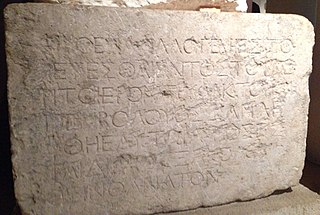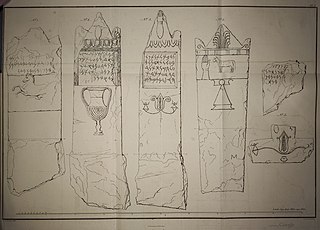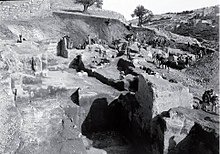
The Via Egnatia was a road constructed by the Romans in the 2nd century BC. It crossed Illyricum, Macedonia, and Thracia, running through territory that is now part of modern Albania, North Macedonia, Greece, and European Turkey as a continuation of the Via Appia.

Charles-Jean-Melchior, Marquis de Vogüé was a French archaeologist, diplomat, and member of the Académie française in seat 18.

The Church of Saint George in the city of Lod is a Greek Orthodox church containing a sarcophagus venerated as the tomb of the fourth-century Christian martyr Saint George.
Al-Burj is a Palestinian village located twenty kilometers (12 mi) southwest of Hebron, in the Hebron Governorate of State of Palestine, in the southern West Bank. According to the Palestinian Central Bureau of Statistics, the village had a population of 3,205 in 2017. The primary health care facilities for the village are designated by the Ministry of Health as level 2. Al-Burj is the birth place of Tareq Talahma, Acting Director of the United Nations Office for the Coordination of Humanitarian Affairs.

Barthélemy Mercier de Saint-Léger was a French abbot and librarian.

The Temple Warning inscription, also known as the Temple Balustrade inscription or the Soreg inscription, is an inscription that hung along the balustrade outside the Sanctuary of the Second Temple in Jerusalem. Two of these tablets have been found. The inscription was a warning to pagan visitors to the temple not to proceed further. Both Greek and Latin inscriptions on the temple's balustrade served as warnings to pagan visitors not to proceed under penalty of death.
Forum Opéra, which is mainly known for its website, Forumopera.com, is a French-language webzine which is dedicated to opera and bel canto since 1999.

The Bodashtart inscriptions are a well-known group of between 22 and 24 Phoenician inscriptions from the 6th century BC referring to King Bodashtart.

The Yehawmilk stele, de Clercq stele, or Byblos stele, also known as KAI 10 and CIS I 1, is a Phoenician inscription from c.450 BC found in Byblos at the end of Ernest Renan's Mission de Phénicie. Yehawmilk, king of Byblos, dedicated the stele to the city’s protective goddess Ba'alat Gebal.

The Neirab steles are two 8th-century BC steles with Aramaic inscriptions found in 1891 in Al-Nayrab near Aleppo, Syria. They are currently in the Louvre. They were discovered in 1891 and acquired by Charles Simon Clermont-Ganneau for the Louvre on behalf of the Commission of the Corpus Inscriptionum Semiticarum. The steles are made of black basalt, and the inscriptions note that they were funerary steles. The inscriptions are known as KAI 225 and KAI 226.

The Bourgade inscriptions are approximately 40 Punic language inscriptions, found in the 1840s and early 1850s in Husainid Tunisia, which had just been opened up to French influence following the 1846 meeting between Ahmad I ibn Mustafa and Antoine, Duke of Montpensier.

The Abydos graffiti is Phoenician and Aramaic graffiti found on the walls of the Temple of Seti I at Abydos, Egypt. The inscriptions are known as KAI 49, CIS I 99-110 and RES 1302ff.

Carthaginian tombstones are Punic language-inscribed tombstones excavated from the city of Carthage over the last 200 years. The first such discoveries were published by Jean Emile Humbert in 1817, Hendrik Arent Hamaker in 1828 and Christian Tuxen Falbe in 1833.

The Cirta steles are almost 1,000 Punic funerary and votive steles found in Cirta in a cemetery located on a hill immediately south of the Salah Bey Viaduct.

Shaqra, officially Chaqra and Doubay, is a local authority in southern Lebanon, 116 km from Beirut; located in the Bint Jbeil District. It consists of two parts: the village Chaqra; while Doubay, located about 4 km west of the village, is a castle dating at least to the Crusader era. Shaqra's inhabitants are called the Shaqrawis.
The Phoenician Adoration steles are a number of Phoenician and Punic steles depicting the adoration gesture (orans).

Hiram's Tomb is a large limestone sarcophagus and pedestal located approximately 6 km southeast of Tyre, Lebanon, near the village of Hanaouay on the road to Qana.

The Ain Nechma inscriptions, also known as the Guelma inscriptions are a number of Punic language inscriptions, first found in 1837 in the necropolis of Ain Nechma, in the Guelma Province of Algeria.

The Guelaât Bou Sbaâ Neopunic inscriptions are two Neopunic inscriptions – one bilingual with Latin – discovered in 1882–84 in Guelaât Bou Sbaâ, about 10 km from Guelma in Algeria.

The Great Omari Mosque of Lod, also known as al-Omari Mosque or the Great Mosque of Lod, is a mosque in the city of Lod (Lydd), in Israel, which is located adjacent to the 19th-century Greek Orthodox Church of Saint George, allegedly erected over the tomb of the fourth-century martyr George of Lydda, who is frequently associated with the Muslim holy figure Al-Khadr.


















